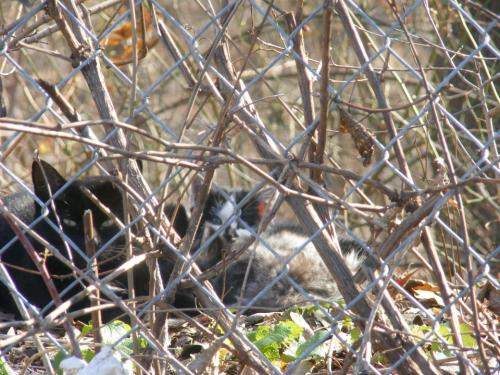Trap Neuter Return (TNR)
Whenever possible, friendly adults and kittens young enough to be easily socialized are removed and placed for adoption.
A designated caretaker provides regular food and shelter to the returned cats and also monitors the colony for newcomers and mediates any conflicts between the cats and the surrounding community.
Advantages of TNR for the local neighborhood:
- No more kittens and a gradually falling population.
- Noise is dramatically reduced.
- Odor becomes much less noticeable.
- Rodent control is maintained.
- A healthier and less visible colony.
- Removal of the pity/sadness factor.
- The presence of a caretaker.
- Prevents a new, unaltered colony from forming.The advantages of TNR when practiced on a community-wide scale:
- Feral and stray cat population reduction for the community as a whole.
- Lower euthanasia rates.
- Fewer complaints to animal control.
- Mobilization of volunteer work force.
- Cost savings. Lower euthanasia rates at local shelters, fewer complaint calls for animal control and the use of a large volunteer work force all save money for municipalities.
- Improved public relations for animal control.Feral vs StrayA “feral” cat is a feline who lives outside a normal home and has to some extent reverted to a wild state. Ferals tend to be fearful of people and keep their distance unless the person is someone they have come to know and trust. They originate from lost or abandoned domestic cats who either became wild themselves after living on their own or parented feral offspring.In contrast to ferals, a “stray” is a lost or abandoned cat who still retains his tame nature.
Most cats living on their own are feral and live in groups called “colonies.” The cats in a colony share territory and a common food source.
Often the cats in a colony are related by family, but not always. Feral colonies can form anywhere there is adequate food and shelter. In urban areas, they can be found in alleyways, vacant lots, abandoned buildings, warehouses, factories, parks and backyards, to name a few.
The vast majority of ferals are not completely wild because they rely on people for their food source, whether it’s a restaurant dumpster or a kind neighbor who comes by once a day. Relatively few subsist by hunting alone.
Cats can be feral to different degrees. Just how wild a cat is will depend on a combination of four factors: Age, Number of generations feral, Amount of human contact, and Personality.
Assessing whether a cat is feral can be relevant to determining what is the best situation for the feline. If the cat is a friendly domestic, then adoption is the best option, but if the cat is feral, then allowing him to live in his own territory with his colony mates might be the most compassionate choice.Info courtesy of NeighborhoodCats.org

Volunteer at the Humane Society of Walden
About Us
The Humane Society of Walden is a no-kill, non-profit safe haven dedicated to helping stray and abandoned cats and dogs. Our animal shelter serves the communities of Montgomery, Walden, Maybrook, Crawford, Wawarsing, Shawangunk, and Mamakating, but will not turn away pets from across the country in need.
Contact Us
Humane Society of Walden
2489 Albany Post Road
Walden, New York 12586
845-778-5115








